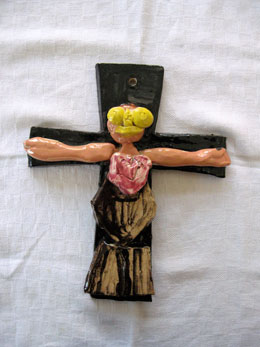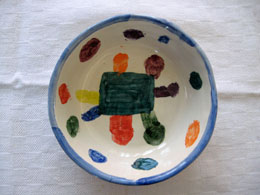Art as Prayer, Prayer as Art
Adapted from a talk given at the “Seeds of Hope” Retreat Series held quarterly at the Dayspring and sponsored by the Henri Nouwen Society, Artist and L’Arche Board Member Jacquie Boughner reflects on the role of Art in the lives of people with intellectual disabilities.
It is a privilege to be part of the discussion about the art and artists in L’Arche. These are teachers with unique insights and gifts, in both art and prayer.
My reflections on ‘Art as Prayer and Prayer as Art” are just that – my own personal interpretations. I encourage you to also listen to your own reactions to these images.

Ceramic Cross by Tom Krysiak
Your reactions might surprise you. My reaction upon seeing a series of crosses like this one (Tom’s cross), in the craft studio was shock, at what looked like 4 or 5 cartoon characters (Homer Simpson in this case) pinned to the crosses.
I had the thought “Is this blaspheme?” and at the same time I felt pure delight/joy at this unintentional aesthetic and theological reinterpretation of religious art. I really had no idea what I was looking at, but I couldn’t stop looking. I knew I was holding a treasure.
I brought them all home with me and just looked at them. I came to a place of admiration and devotion to this – very personal, very broken, very truthful interpretation of the heart of Jesus were only love exists.
Art is completed in the viewer and like any meaningful relationship; it is a process of spending time together.
In Henri Nouwen’s writings about art, you can tell that first of all, he loved the arts and how they enriched his life, and secondly that he spent a lot of time just being present to a relationship with art, and the interior dialogue that results. And from that interior dialogue, he had a wonderful ability to articulate the language of art for us in a personal context.
In ‘Behold the Beauty of the Lord’ Henri wrote: icons “are created for the sole purpose of offering access, through the gate of the visible, to the mystery of the invisible. Icons are painted to lead us into the inner room of prayer and bring us close to the heart of God.”
This morning we will look at core member art as icons that lead us into that inner room of prayer, as windows through which to see the heart of God.
Art has been called a continuing gesture of creation. Let us begin with God’s first words in Genesis – at the moment of creation.
“And the Spirit of God was hovering over the face of the waters. Then God said. “Let there be light”; and there was light.”(Gen 1: 3) Let there be.
St. Boniventure said that Jesus is the art of God. Let us listen to Mary’s words at the moment of Jesus’ incarnation ” Behold the maidservant of the Lord, let it be to me according to your word”. (Luke 1:38) Let it be.
‘Let there be’ and ‘let it be’ are the words said at these two sacred acts of creation in which we live and have our being. As we look at core member art as icons for prayer and art, let us hold these words ‘let it be’ in our hearts and minds.
My first reaction to core member art was a connection to its spontaneity. But I didn’t know what to call it. I knew what it wasn’t. It wasn’t professional art, amateur art or folk art.
What I did know was that the art in L’Arche has a profound presence of liberation, an ability to ‘let be’. A freedom rooted in our human reality and physicality that transcends the body, and that paradoxically we intuitively experience in our own body. We don’t think/intellectualize this work as a narrative. We physically feel this work as a gesture.
And so I call this art, wisdom art and wisdom icons, because they illustrate a central truth about the creative artistic act, and also a central truth about our own creative spiritual relationship with God.
Several years ago, I had a revealing conversation with a friend of mine, an artist. As background let me tell you that their work is in the National Gallery of Canada, the Guggenheim, and the Museum of Modern Art in New York. He has the Order of Canada and a life membership at Clare Hall, Cambridge etc. In the art world, he has an international reputation.
This artist was in my kitchen talking intensely, when suddenly he stopped and picked up a little ceramic dish, cradled it in his hands and said with wonderment, ” This is beautiful. Who made this?”

Ceramic Bowl, by Stephen Richardson
I said, “a core member from L’Arche Daybreak”. The look of wonderment changed to one of confusion. This wasn’t the answer he expected. He began looking around the room at different paintings and there were several pieces, all by professional artists.
His gaze found a small watercolor on top of the refrigerator. “There”, he said, “that’s beautiful. Yes, I like that. Who did that?”
I said, “A core member from L’Arche Calgary”. At which point, he shook his head and laughed in bewilderment. So I said to him, “God has created the little to confound the wise.”
He had selected the only two pieces of core member art in that room. What was it in those two small pieces that this artist immediately recognized?
To begin to answer that question, let me quote Rowan Williams, the Archbishop of Canterbury. (2005 Oxford lecture,’ Creation, Creativity and Creatureliness: The Wisdom of Finite Existence’)

“The human calling to share the love and the liberty of God has to be in this perspective – a calling to ‘let be’. The paradox of real human creativity is that it is not the flexing of our human – our created will… the imposing of order, the dredging up of something new out of the depths of our interiority.
Our creativity is most fully and freely expressed as humans, when we, as artists, stand back and let be…That it is so far from being an exercise of will – much more an exercise of the most extraordinarily concentrated ‘suspension’ of will, so that something is allowed to happen…. “He continues: “Many years ago I used to meet regularly with a rather formidable Canadian sculptor who wanted to talk about what he was doing. And he would say passionately again and again, “will has nothing to do with it. I must let it happen.”
Because the paradox is that letting it happen for any artist is a hugely laborious business; it’s not a recipe for sitting back…simply, the creative artist is doing a kenotic (emptying) job; allowing the rhythm of the deepest reality to become transparent in your acts – your imagination, requires a real discipline of self-forgetting.” The formidable sculptor, Williams quotes, was the artist in my kitchen. “Will has nothing to do with it. I must let it happen.” In other words, the essence of creativity in core member art that my friend identified is the quality of selflessness, of vulnerability and of stepping aside from the ego – letting the gesture be in the moment of the deepest impulse of life, and of being free in the gift of life – of ‘letting be’ the continuing gesture of creation.
When I later mentioned Williams’ quote to my artist friend, he said,” Yes, he is right, but you know the making of art and the artist is not some kind of religious act or person.” Another way to explain my friend’s response is to quote Thomas Merton, a formidable 20th c theologian, whose parents were both artists. Merton said the artistic language and the spiritual language are similar but different. Both viewpoints are helpful in looking at core member art, and how this relates to prayer – similar but different. A work of art engages us on several levels. In very general terms – the intellect (head) is engaged by the subject matter. The emotions (heart) are engaged by colour and composition. The technical competence of the artist engages our confidence in the articulation of the work.
Then there is the artist’s indefinable ability to ‘let be’, to let the spirit (inspiration) be present for the work to be alive. Our sense of whether the art is alive or has energy is engaged by the artist’s gesture to ‘let be’. This is where we glimpse the life, and the mystery of the work. A work of art is the inter-relatedness, interconnectedness of all of the above that transcends its individual parts. In core member art, what engages us deeply and intuitively, is not only the subject matter, colour or composition, although these are appealing, but it is the intensity and commitment of the gesture of the paint applied to a surface – the personality, nervousness of the line, the pressure with which the paint is applied.
This is not about the skill of technical ability. It is simply that the gesture is alive, and has ‘let be’ the energy of life. We respond in our physical body – we feel and intuit the gesture. It is a physical marking that communicates directly to our physical body the spirit and gift of life. Similarly but differently, in prayer – it is when the Holy Spirit intercedes for us, to the Spirit of God. When our body can only express itself with uninterruptible sounds – groans of pain, despair, loneliness that even we do not understand, but God does and we trust that God understands because of the Spirit’s promise to advocate for us.
We read in (Romans 8: 26 – 27) “The Spirit helps us in our weakness; for we do not know how to pray as we ought, but that very Spirit intercedes with sighs too deep for words”. The style or voice of an artist is the way an art medium is personally applied or manipulated – how we identify and recognize a Van Gogh, a Rembrandt, and differentiate between them. Core members, each have their own individual artistic style. This personal voice, this characteristic identity is a non-language that also communicates.
Similarly but differently, in prayer – it is a gift of the Spirit. When the body, silently or with sounds or gestures, conveys a personalized way of communicating with God that is unique to each of us. A personalized way of our inner self being bare, vulnerable and present before God. We read in (1Cor14: 2) ‘For he who speaks in an unknown tongue does not speak to men but to God, for no one understands him; however, in the spirit he speaks mysteries.’ The artist’s observation “will has nothing to do with it. I must let it happen” also describes our attitude approaching prayer and our desire to continue in prayer with an open heart.
The gestures in core member art display a freedom from striving, from ‘trying to make it happen’. They are gestures of gratitude and wonder – of being alive in the moment. In prayer we come before God ‘just as we are’ and we ‘let be’ whatever the truth of that moment is for us– joy, sadness, grief, doubt etc. In this creative silence,’ just as we are’ with open hearts, we listen with our spiritual ears, and see with our spiritual eyes ‘the rhythm of the deepest reality’ of God’s infinite unconditional love for each of us as beloved. To be loved and to love – that is what we ‘let be’ in our prayers.
Core member art reminds us that the gesture of ‘letting be’ ourselves – this point of vulnerability in prayer is beyond words, beyond physical and intellectual abilities, beyond good works. It is a process of vulnerability and trusting in God’s love. Wisdom icons invite us to contemplate these visual gestures that have at their heart the gift of life, the gift of the beloved and the way of vulnerability ‘to let be’ as a relationship of love with God. The gift of this art is to deepen the mystery of God’s love – the mystery, the wonder that at the point of complete vulnerability before and in God’s love, we are only capable of love, given and received.
“I pray that these icons will imprint themselves upon your heart and strengthen the awareness of God’s magnificent and loving presence in your life. May they become faithful guides on your journey and vital sources of lasting joy and peace.” (Henri Nouwen, Behold the Beauty of the Lord)
© 2023 Copyright L'Arche Daybreak
WordPress Website Support by IDL Web Inc



